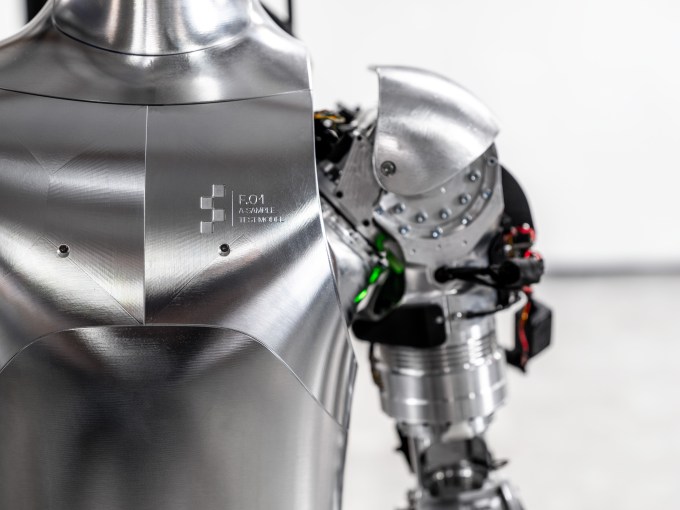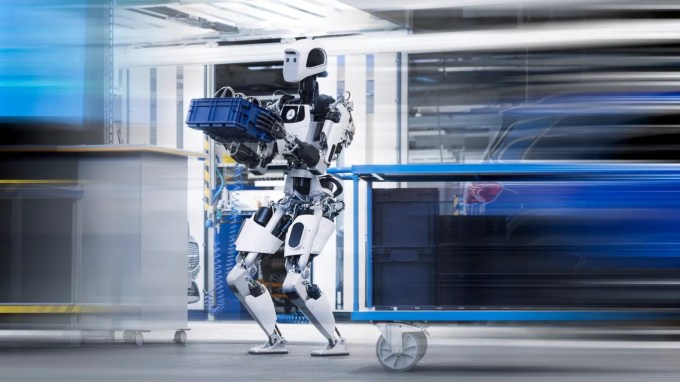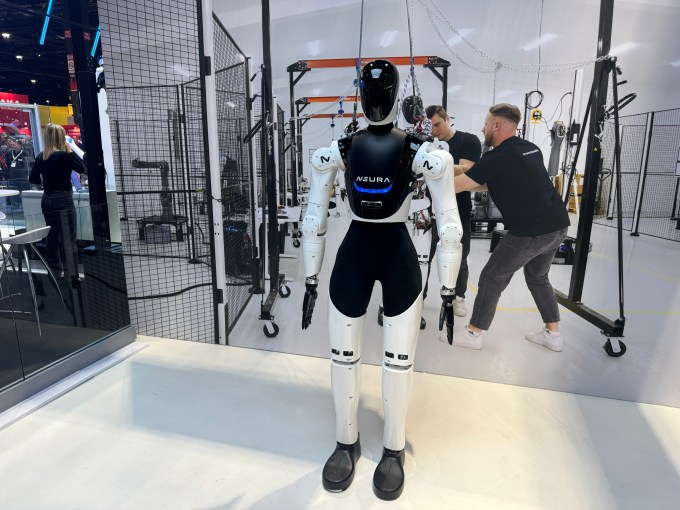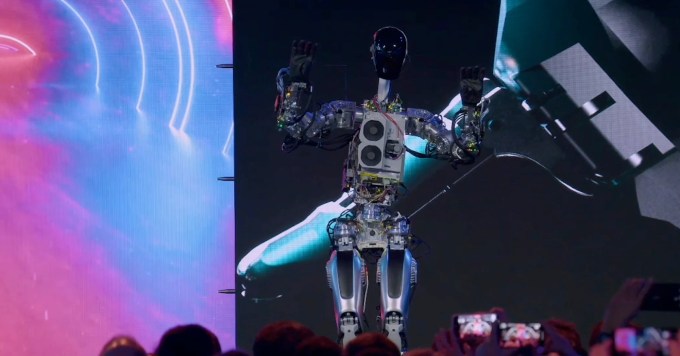Industries may be ready for humanoid robots, but are the robots ready for them?

You could easily walk the entire Automate floor without spotting a single humanoid. There was a grand total of three, by my count — or, rather, three units of the same nonworking prototype. Neura was showing off its long-promised 4NE-1 robot, amid more traditional form factors. There was a little photo setup where you could snap a selfie with the bot, and that was about it.
Notably absent at the annual Association for Advancing Automation (A3) show was an Agility booth. The Oregon company made a big showing at last year’s event, with a small army of Digits moving bins from a tote wall to a conveyer belt a few feet away. It wasn’t a complex demo, but the mere sight of those bipedal robots working in tandem was still a showstopper.
Agility chief product officer Melonee Wise told me that the company had opted to sit this one out, as it currently has all the orders it can manage. And that’s really what these trade shows are about: manufacturers and logistics companies shopping around for the next technological leg up to remain competitive.
How large a role humanoids will play in that ecosystem is, perhaps, the biggest question on everyone’s mind at the moment. Amid the biggest robotics hype cycle I’ve witnessed firsthand, many are left scratching their heads. After all, the notion of a “general purpose” humanoid robot flies in the face of decades’ worth of orthodoxy. The notion of the everything robot has been a fixture of science fiction for the better part of a century, but the reality has been one of single-purpose systems designed to do one job well.
While there wasn’t much of a physical presence, the subject of humanoids loomed large at the event. As such, A3 asked me to moderate a panel on the subject. I admit I initially balked at the idea of an hourlong panel. After all, the ones we do at Disrupt tend to run 20 to 25 minutes. By the end of the conversation, however, it was clear we easily could have filled another hour.
That was due, in part, to the fact that the panel was — as one LinkedIn commenter put it — “stacked.” Along with Wise, I was joined by Boston Dynamics CTO Aaron Saunders, Apptronik CEO Jeff Cardenas and Neura CEO David Reger. I kicked the panel off by asking the audience how many in attendance would consider themselves skeptical about the humanoid form factor. Roughly three-quarters of the people present raised their hands, which is more or less what I’d anticipate at this stage in the process.
As for A3, I would say it has entered the cautiously optimistic phase. In addition to hosting a panel on the subject at Automate, the organization is holding a Humanoid Robot Forum in Memphis this October. The move echoes the 2019 launch of A3’s Autonomous Mobile Robot (AMR) Forum, which presaged the explosive growth in warehouse robotics during the pandemic.
Investors are less measured in their optimism.

“A year after we laid our initial expectations for global humanoid robot [total addressable market] of $6bn, we raise our 2035 TAM forecast to $38bn resulting from a 4-fold increase in our shipments estimate to 1.4mn units with a much faster path to profitability on a 40% reduction in bill of materials,” Goldman Sachs researcher Jacqueline Du wrote in a report published in February. “We believe our revised shipment estimate would cover 10%-15% of hazardous, dangerous and auto manufacturing roles.”
There are, however, plenty of reasons to be skeptical. Hype cycles are hard to navigate when you’re in the middle of them. The amount of money currently changing hands (see: Figure’s most recent raise of $675 million) gives one pause in the wake of various startup collapses across other fields. It also comes during a time when robotics investments have slowed after a few white-hot years.
One of the biggest risks at this stage is the overpromise. Every piece of new technology runs this risk, but something like a humanoid robot is a lightning rod for this stuff. Much like how eVTOL proponents see the technology as finally delivering on the promise of flying cars, the concept of personal robot servant looks within reach.
The fact that these robots look like us leads many to believe they can — or soon will be able to — do the same things as us. Elon Musk’s promise of a robot that works in the Tesla factory all day and then comes home to make you dinner added fuel to that fire. Tempering expectations isn’t really Musk’s thing, you know? Others, meanwhile, have tossed around the notion of a general intelligence for humanoid robots — a thing that is a ways off (“five to 10 years” is a time frame I often hear bandied about).

“I think we need to be careful about the hype cycles, because we ultimately need to deliver the promise and potential,” Cardenas said. “We’ve been through this before, with the DARPA Robotics challenge, where there’s a lot of excitement going into it, and we crashed into reality coming out of that.”
One source of disconnect is the question of what these systems can deliver today. The answer is murky, partly because of the nature of partnership announcements. Agility announced it was working with Amazon, Apptronik with Mercedes, Figure with BMW and Sanctuary AI with Magna. But every partnership so far needs to be taken for what it is: a pilot. The precise number of robots deployed in any specific partnership is never disclosed, and the figure is often single digits. It makes perfect sense: These are all operating factories/warehouses. It would be wildly disruptive to just slot in a new technology at scale and hope for the best.
Pilots are important for this reason, but they should not be mistaken for market fit. As of this writing, Agility is the only one of the bunch that has confirmed with TechCrunch that it’s ready for the next step. On the discussion panel, Wise confirmed that Agility will be announcing specifics in June. Cardenas, meanwhile, stated that the company plans to heavily pilot in the “back half” of 2024, with plans to move beyond early next year.
Neura and Boston Dynamics are simply too early stage for the conversation. Neura promised to show off some demos at some point in July, moving 4NE-1 beyond what has up until now been a series of rendered videos, coupled with the nonfunctioning units shown at Automate.
As for when we’ll see more of the electric Atlas beyond a 30-second video, Saunders says, “[the video] is just meant to be an early peek. We’re planning on getting into the pilot and some of the more pragmatic pieces next year. So far, we’re focused mainly on building up the focus and technology. There are a lot of hard problems left to solve in the manipulation and the AI spaces. Our team is working on it right now, and I think as those features get more robust, we’ll have more to show off.”

Boston Dynamics isn’t starting from scratch, of course. After more than a decade of Atlas, the company has as much humanoid expertise as any, while the launches of Spot and Stretch have taught the firm plenty about commercializing products after decades of research.
So, why did it take so long to see the company’s swing at the commercial humanoid category? “We wanted to make sure that we understood where the value is placed,” Saunders said. “It’s really easy to make demo videos and show cool things, but it takes a long time to find ROI [return on investment] cases that justify the human form.”
Neura has easily the most diverse portfolio of the companies present onstage. In fact, one gets the sense that whenever the company is finally ready to launch a humanoid in earnest, it will be just another form factor in the company’s portfolio, rather than the driving force. Meanwhile, when the electric Atlas eventually launches, it will be Boston Dynamics’ third commercially available product.
As Digit is Agility’s only offering at the moment, the company is wholly committed to the bipedal humanoid form factor. For its part, Apptronik splits the difference. The Austin-based firm has been taking a best-tool-for-the-job approach to the form factor. If, for example, legs aren’t needed for a specific environment, the company can mount the upper half of its robot onto a wheeled base.

“I think at the end of the day, it’s about solving problems,” Cardenas said. “There are places where you don’t need a bipedal robot. My view is that bipedal form factors will win the day, but the question is how do you actually get them out there?”
Not every terrain requires legs. Earlier this week, Diligent Robotics co-founder and CEO Andrea Thomaz told me that part of the reason her company targeted healthcare first is the prevalence of ADA (Americans with Disabilities Act) compliant structures. Anywhere a wheelchair can go, a wheeled robot should be able to follow. Because of that, the startup didn’t have to commit to the very difficult problem of building legs.
Legs have benefits beyond the ability to handle things like stairs, however. Reach is an important one. Legged robots have an easier time reaching lower shelves, as they can bend at the legs and the waist. You could, theoretically, add a very large arm to the top of an AMR, but doing so introduces all kinds of new problems like balance.
Safety is something that has thus far been under-addressed in conversations around the form factor. One of humanoid robots’ key selling points is their ability to slot into existing workflows alongside other robotic or human co-workers.
But robots like these are big, heavy and made of metal, therefore making them a potential hazard to human workers. The subject has been top of mind for Wise, in particular, who says further standards are needed to ensure that these robots can operate safely alongside people.
For my part, I’ve been advocating for a more standardized approach to robot demos. Videos of humanoids, in particular, have obscured what these robots can and can’t do today. I would love to see disclosures around playback speed, editing, the use of teleop and other tricks of the trade that can be used to deceive (intentionally or not) viewers.
“It’s very hard to distinguish what is and isn’t progress,” Wise said, referring to some recent videos of Tesla’s Optimus robot. “I think one thing that we, as a community, can do better is being more transparent about the methodologies that we’re using. It’s fueling more power for the hype cycle. I think the other problem that we have is, if we look at what’s going on with any humanoid robot in this space, safety is not clear. There isn’t an e-stop on Optimus. There isn’t an e-stop on many of our robots.”



